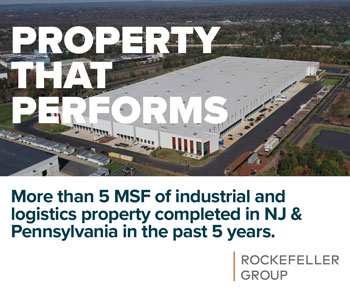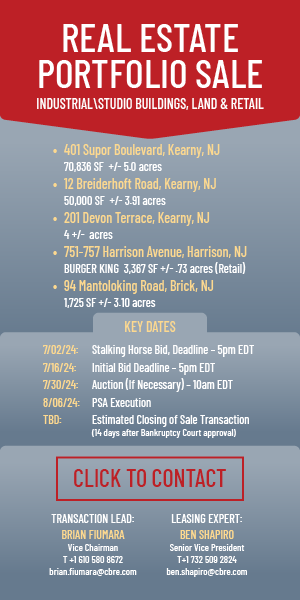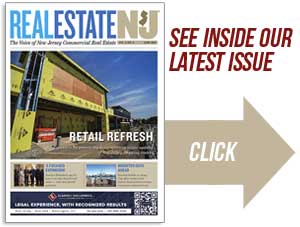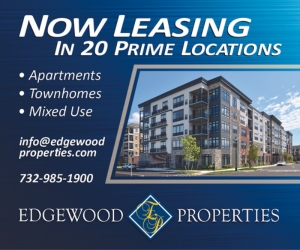By Joshua Burd
The longevity of a firm such as Levin Management Corp. would be a triumph in just about any line of work, but perhaps the true feat is sticking to one core focus over its 65 years in business.
For the North Plainfield-based firm, that focus has been shopping centers — from when Philip Levin pioneered open-air retail development in the state in 1952 to today, when it has a third-party management portfolio that spans 13 million square feet.
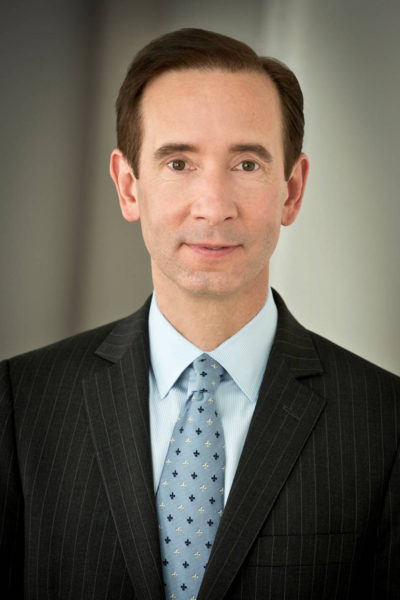
“That does give us a great deal of pride,” said Matthew Harding, president and chief operating officer of Levin Management Corp., or LMC. “And we’ve also navigated our way and our clients through a lot of ups and downs in the economy that impact retail real estate over the decades.
“So the longevity and the collective industry knowledge that we have here is something we’re all very proud of.”
Aside from its focus on retail property, LMC executives say change is one of the only other constants in their business. It’s one reason why they feel they’re built to withstand the next set of shifts and challenges to an industry that is evolving as quickly as ever.
Harding, who has been affiliated with the firm since 1986, said “bricks-and-mortar shopping isn’t going to go away.” For one thing, he points to investment into physical retail spaces by a powerhouse such as Amazon, along with other e-commerce players that are now exploring their own store locations.
But there’s no denying the impact of rapidly changing consumer patterns.
“I think going forward … there’s probably going to be less retail out there, so you’re going to end up with winners and losers in that equation,” Harding said. “Location is probably going to drive some of that, but also, if an owner is complacent, oftentimes they’re not going to end up on the winning side of the ledger.
“So it’s really something that requires more focus and more day-to-day attention than it used to.”
Harding and his team will carry that mindset forward as they look to continue their growth as a service provider for retail owners. The firm this year has added about 10 properties totaling 1.5 million square feet to its portfolio, which now includes about 100 sites, and it hopes to keep up that pace going into 2018.
Real Estate NJ recently spoke with Harding to discuss those plans and the state of the retail real estate market. Below are excerpts from the interview.
Real Estate NJ: Since you provide third-party services, let’s start with this. How would you describe your typical client?
Matthew Harding: Our typical client is an investor or an owner that really wants to do the best for their property, so they’re hiring professional management and leasing. A good number of our clients are institutions, but we also have a good number of private owners as well who are owners of real estate that either don’t handle things themselves or see that we’re in a really rapidly changing environment and that the business has become more complicated. And oftentimes they see that it’s best to hand off management, leasing and construction management — all the things that we do — or one or a couple of those components to someone that does it day in and day out for their business.
RENJ: What about your typical property or assignment?
MH: We look for properties of some reasonable size and quality, to a certain extent. We want to be in alignment with the owner, in that we’re trying to keep the property in good shape and improve it. The best-case scenario is where we can apply all of our skills … all together. It really provides the best working environment and the best results, we often think, although many times we do just parts of those, be it just leasing or just management.
RENJ: As an outside observer, it seems like you’re doing more construction management and renovation work these days. Is that a fair assessment?
MH: I think part of that is sort of the changing nature of our business. In general, oftentimes a national tenant is asking for more work these days than they used to. The landlord may need to build a turnkey space or close to that, so that’s adding to a landlord’s obligations, whereas previously you might have gotten away with maybe an ‘as is’ deal or just some more fundamental improvements to the space. But big national tenants these days often have a lot of opportunities and increasingly — not in all cases, by any means, as different tenants have different objectives — you see more deals that require more work. So I think that drives it a little bit.
Also, you can’t rest on your laurels anymore. And you really want a property to be the best that it can be within in a market. Every property isn’t going to be the Short Hills Mall, but you also can’t sit idly by.
So some of those common area capital improvements and façade renovations are also driving some of that construction management business that we do for our clients. And then there are expansions.
We’re also looking at more reconfigurations to meet the needs of today’s retailers. We’re reworking some old department store boxes or supermarket boxes. Sometimes those have to come down completely and get rebuilt, so that’s not the most simple process in terms of design, construction, entitlements, permitting, bidding. That’s everything that we do day in and day out, so there is a lot of that kind of work going on as you have to rework things as well for retailers.
RENJ: Are there more outside, first-time investors coming in that are providing opportunities for third-party services?
MH: I would say that the majority of our clients are folks who have been generally in the retail business or the commercial real estate business for a while. So you do see, I think, some investors migrating … and making more investments in the suburbs, as pricing and so forth has changed1 a bit in the city and they see other opportunities in the suburbs. You do see some of that going on, so there are maybe folks that are new to the market, but not necessarily new to the industry.
RENJ: For a firm that has been focused on open-air shopping centers for decades, what are some of the big changes you’re seeing and how are you handling that?
MH: The world of tenants that you have to try to attract to your properties is smaller. So you really have to be on top of your marketing, on top of the physical plant at the property and really communicating and engaging with the tenants to explain why they should be in the center. Tenant retention is very important as well — working with existing tenants to keep them, renew them, expand if possible or expand them into additional stores in different locations.
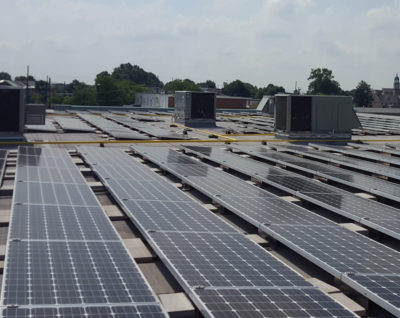
So I would say, in general, just having a smaller group of prospects to go to is the thing confronting people these days in leasing space in shopping centers.
On a positive note, we’re doing a lot with open-air shopping centers in terms of curb appeal, landscaping, energy efficiency and those types of things — converting to LED lighting, for example. We’re adding some solar projects, so there are a lot of very positive things to also help the tenants in the property.
RENJ: How are all of these changes that we’ve been discussing going to impact the retail owner or investor?
MH: I think it is going to perhaps change the type of investor over the intermediate term in a lot of retail real estate. It’s probably going to require a little bit more capital to keep your game up and be able to deal with national and some regional tenants, which has become more of a complicated business than it used to be. … I think the ins and outs of a deal have become more complicated — having to do more work, having to build a turnkey store for a national tenant. That’s not necessarily so simple for somebody to do right, with all of the timelines and the dates to hit.
It’s just become a lot more structured. In some cases, it has taken tenants longer times to make decisions and in other cases they’re rolling very quickly to take space.
RENJ: We hear a lot these days about experiential retail and other lifestyle-oriented tenants. Are you seeing that reflected in your portfolio?
MH: (We’re seeing owners add) restaurants and trying to add life to a property throughout the day, a place for people hang out. So restaurants definitely fulfill that need and bring people to a center and add life and vitality to the center.
We’ve had great experience with gyms in a whole wide variety of types of tenants and sizes, but they’re really a great add to a shopping center, bringing a total destination tenant. Customers are coming there just for them, but then can shop at the other stores and also throughout the day.
RENJ: What about grocery stores, which seems to be one of the more time-tested categories?
MH: In terms of something that’s really going to add value — and it’s an interesting category these days — grocery stores are still a very important draw to a shopping center, bringing customers most frequently during the week to a property. So we’re working where we can with some of the new entrants into the market such as Lidl. And we’re working with existing tenants that we have in improving and expanding their stores and working on a smaller basis with some more regional, ethnic types of tenants as well.
So that category is still a good one. And Amazon didn’t buy a chain of 450 bricks-and-mortar stores because they’re going to put them out of business, so we can see life and longevity to the insulation of that business from e-commerce to a certain extent. However, that’s a really key place where tenants can’t rest on their laurels. They have to reinvest, they have to up their game in terms of presentation, merchandise, ease of access, ordering online. And certainly Amazon’s investment there is going to spur that change to move faster — and that’s a positive thing, too.
Bright ideas
The race to keep and attract tenants has led to new investment and innovation at retail properties. Levin Management Corp. has seen this firsthand, pointing to a solar panel installation alongside a 360,000-square-foot shopping center in Ewing.
The owners of the property, known as Capitol Plaza, last year marked the addition of more than 1,000 solar panels on the roof of an adjoining office building. The system is meant to increase efficiency and reduce annual utility costs at the overall complex by supplementing its electric power with a clean, alternative energy source.
Along with the environmental benefits, the management team has sought to monetize the installation. Under a state incentive program, the property can earn credits come from its generation of solar power, which can then be sold to utility operators to help them satisfy renewable energy requirements.

“It’s a great example of why this project made financial sense in addition to being environmentally responsible, and is a positive investment in the shopping center’s future,” LMC Executive Vice President Robert Carson said last fall. “Based on this experience at Capitol Plaza, we are exploring additional solar opportunities throughout our portfolio.”
Capitol Plaza sits on North Olden Avenue at the junction of Route 206 in Ewing, featuring retailers such as dd’s Discounts, Forman Mills, Marshalls and Save-A-Lot supermarket. The solar array has helped create value at the property, LMC President Matthew Harding said, adding that the firm is now exploring a similar project in Middlesex County.
“We see doing more of that, as long as the incentives are there to make it make sense, which is one of the keys to helping folks to try to make that investment,” Harding said.
At Capitol Plaza in Ewing, a 360,000-square-foot property for which Levin Management Corp. serves as the manager and leasing agent, ownership last year added more than 1,000 solar panels on the roof of an adjoining office building. The system is meant to increase efficiency and reduce annual utility costs at the overall complex by supplementing its electric power with a clean, alternative energy source.



